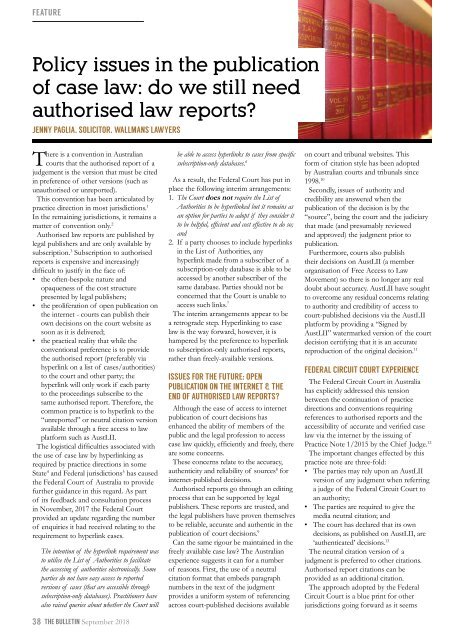LSB September 2018_Web
You also want an ePaper? Increase the reach of your titles
YUMPU automatically turns print PDFs into web optimized ePapers that Google loves.
FEATURE<br />
Policy issues in the publication<br />
of case law: do we still need<br />
authorised law reports?<br />
JENNY PAGLIA, SOLICITOR, WALLMANS LAWYERS<br />
There is a convention in Australian<br />
courts that the authorised report of a<br />
judgement is the version that must be cited<br />
in preference of other versions (such as<br />
unauthorised or unreported).<br />
This convention has been articulated by<br />
practice direction in most jurisdictions. 1<br />
In the remaining jurisdictions, it remains a<br />
matter of convention only. 2<br />
Authorised law reports are published by<br />
legal publishers and are only available by<br />
subscription. 3 Subscription to authorised<br />
reports is expensive and increasingly<br />
difficult to justify in the face of:<br />
• the often-bespoke nature and<br />
opaqueness of the cost structure<br />
presented by legal publishers;<br />
• the proliferation of open publication on<br />
the internet - courts can publish their<br />
own decisions on the court website as<br />
soon as it is delivered;<br />
• the practical reality that while the<br />
conventional preference is to provide<br />
the authorised report (preferably via<br />
hyperlink on a list of cases/authorities)<br />
to the court and other party; the<br />
hyperlink will only work if each party<br />
to the proceedings subscribe to the<br />
same authorised report. Therefore, the<br />
common practice is to hyperlink to the<br />
“unreported” or neutral citation version<br />
available through a free access to law<br />
platform such as AustLII.<br />
The logistical difficulties associated with<br />
the use of case law by hyperlinking as<br />
required by practice directions in some<br />
State 4 and Federal jurisdictions 5 has caused<br />
the Federal Court of Australia to provide<br />
further guidance in this regard. As part<br />
of its feedback and consultation process<br />
in November, 2017 the Federal Court<br />
provided an update regarding the number<br />
of enquiries it had received relating to the<br />
requirement to hyperlink cases.<br />
The intention of the hyperlink requirement was<br />
to utilise the List of Authorities to facilitate<br />
the accessing of authorities electronically. Some<br />
parties do not have easy access to reported<br />
versions of cases (that are accessible through<br />
subscription-only databases). Practitioners have<br />
also raised queries about whether the Court will<br />
38 THE BULLETIN <strong>September</strong> <strong>2018</strong><br />
be able to access hyperlinks to cases from specific<br />
subscription-only databases. 6<br />
As a result, the Federal Court has put in<br />
place the following interim arrangements:<br />
1. The Court does not require the List of<br />
Authorities to be hyperlinked but it remains as<br />
an option for parties to adopt if they consider it<br />
to be helpful, efficient and cost effective to do so;<br />
and<br />
2. If a party chooses to include hyperlinks<br />
in the List of Authorities, any<br />
hyperlink made from a subscriber of a<br />
subscription-only database is able to be<br />
accessed by another subscriber of the<br />
same database. Parties should not be<br />
concerned that the Court is unable to<br />
access such links. 7<br />
The interim arrangements appear to be<br />
a retrograde step. Hyperlinking to case<br />
law is the way forward, however, it is<br />
hampered by the preference to hyperlink<br />
to subscription-only authorised reports,<br />
rather than freely-available versions.<br />
ISSUES FOR THE FUTURE: OPEN<br />
PUBLICATION ON THE INTERNET & THE<br />
END OF AUTHORISED LAW REPORTS?<br />
Although the ease of access to internet<br />
publication of court decisions has<br />
enhanced the ability of members of the<br />
public and the legal profession to access<br />
case law quickly, efficiently and freely, there<br />
are some concerns.<br />
These concerns relate to the accuracy,<br />
authenticity and reliability of sources 8 for<br />
internet-published decisions.<br />
Authorised reports go through an editing<br />
process that can be supported by legal<br />
publishers. These reports are trusted, and<br />
the legal publishers have proven themselves<br />
to be reliable, accurate and authentic in the<br />
publication of court decisions. 9<br />
Can the same rigour be maintained in the<br />
freely available case law? The Australian<br />
experience suggests it can for a number<br />
of reasons. First, the use of a neutral<br />
citation format that embeds paragraph<br />
numbers in the text of the judgment<br />
provides a uniform system of referencing<br />
across court-published decisions available<br />
on court and tribunal websites. This<br />
form of citation style has been adopted<br />
by Australian courts and tribunals since<br />
1998. 10<br />
Secondly, issues of authority and<br />
credibility are answered when the<br />
publication of the decision is by the<br />
“source”, being the court and the judiciary<br />
that made (and presumably reviewed<br />
and approved) the judgment prior to<br />
publication.<br />
Furthermore, courts also publish<br />
their decisions on AustLII (a member<br />
organisation of Free Access to Law<br />
Movement) so there is no longer any real<br />
doubt about accuracy. AustLII have sought<br />
to overcome any residual concerns relating<br />
to authority and credibility of access to<br />
court-published decisions via the AustLII<br />
platform by providing a “Signed by<br />
AustLII” watermarked version of the court<br />
decision certifying that it is an accurate<br />
reproduction of the original decision. 11<br />
FEDERAL CIRCUIT COURT EXPERIENCE<br />
The Federal Circuit Court in Australia<br />
has explicitly addressed this tension<br />
between the continuation of practice<br />
directions and conventions requiring<br />
references to authorised reports and the<br />
accessibility of accurate and verified case<br />
law via the internet by the issuing of<br />
Practice Note 1/2015 by the Chief Judge. 12<br />
The important changes effected by this<br />
practice note are three-fold:<br />
• The parties may rely upon an AustLII<br />
version of any judgment when referring<br />
a judge of the Federal Circuit Court to<br />
an authority;<br />
• The parties are required to give the<br />
media neutral citation; and<br />
• The court has declared that its own<br />
decisions, as published on AustLII, are<br />
‘authenticated’ decisions. 13<br />
The neutral citation version of a<br />
judgment is preferred to other citations.<br />
Authorised report citations can be<br />
provided as an additional citation.<br />
The approach adopted by the Federal<br />
Circuit Court is a blue print for other<br />
jurisdictions going forward as it seems


















